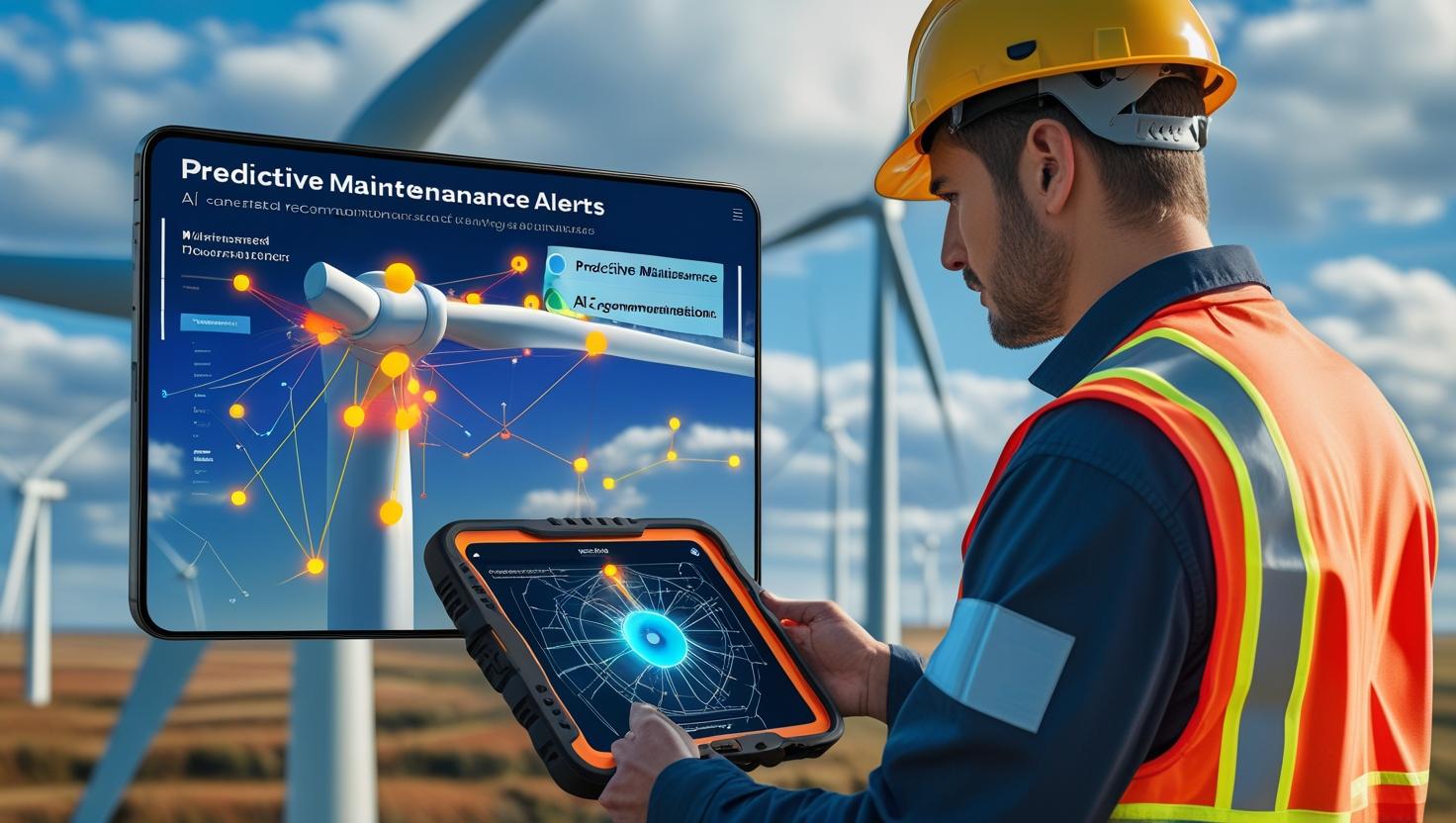How does machine learning in the energy sector drive innovation and efficiency in energy production and management?
The sector faces disruption from volatile prices, aging infrastructure, and climate pressure. As a business leader, resilience and foresight are essential. Machine learning is now emerging as a catalyst for smarter operations, cleaner systems, and long-term advantage.
This article explores how machine learning development is transforming energy sector. You will discover how it enhances forecasting, cuts downtime, and improves margins across the value chain.
The crossroads are clear. Investing now means you can hire machine learning developers and build a leaner, smarter energy future.
How Machine Learning Powers the Energy Sector
Machine learning is reshaping energy systems by turning raw data into strategic, operational, and environmental intelligence. Below are four key domains where it delivers measurable impact.

a. Data-Driven Decision Making
Energy businesses generate vast quantities of data from grid sensors, weather models, field equipment, and consumer systems. Machine learning enables real-time analysis of this data, allowing leaders to act faster and with greater accuracy.
Through advanced algorithms, businesses can detect inefficiencies, forecast energy demand, and allocate resources based on predictive models. Real-time data pipelines also improve transparency and shorten response cycles.
When supported by big data and analytics services, this data becomes a decision-making asset. Governance frameworks and master data management ensure consistency and traceability across systems.
These foundations are essential for enterprise-grade business intelligence, especially for organizations managing diverse assets or operating in multiple regions.
b. Operational Optimization
Maintenance delays and asset failures can result in significant losses. Machine learning models can predict when components in wind turbines, oil rigs, or nuclear facilities are likely to fail.
Predictive maintenance, enabled by machine learning development, reduces unplanned outages and extends asset life. This leads to reduced downtime and operational savings.
Smart grid management is another frontier. AI systems balance load, detect grid disturbances, and reroute power in real-time. These technologies ensure stability and reliability, even in times of peak usage.
Demand response is also improved. AI forecasts usage spikes, recommends load adjustments, and automates decisions. This allows energy providers to align generation with consumption patterns more precisely.
By partnering with an AI development service provider, companies can custom-build systems tailored to their operational landscapes and compliance needs.
c. Sustainability and Efficiency
Machine learning is critical for improving the sustainability of energy operations. Renewable energy sources such as solar and wind are intermittent by nature. ML models forecast availability based on weather, historical trends, and sensor data.
These predictions allow better integration of renewables into the grid, avoiding waste and improving reliability. AI also optimizes carbon capture processes, waste-to-energy initiatives, and emissions tracking systems.
Many energy firms now work with a custom software development company to embed AI into sustainability reporting and compliance systems. This ensures accurate tracking and supports environmental, social, and governance (ESG) targets.
Reducing emissions is no longer a branding effort. It is an operational necessity, and machine learning delivers the precision to meet both economic and environmental goals.
d. Market and Consumer Solutions
Beyond operations, machine learning opens new value streams in market-facing services. AI systems now support real-time energy trading, reacting faster than human traders and maximizing margins.
Smart meter analytics help utilities understand consumption patterns, detect anomalies, and offer personalized billing. For consumers, this results in better control and more transparent pricing.
Electric vehicle infrastructure also benefits. AI helps manage charging loads, optimize locations, and reduce grid strain during high demand periods.
Machine learning also supports fraud detection in energy systems. It monitors transactions, detects unusual patterns, and alerts stakeholders to suspicious activities.
By choosing to hire machine learning developers with domain experience, energy companies can create solutions that fit regulatory frameworks and consumer expectations alike.
Real-Life Examples of Leveraging ML in the Energy Sector
- Adopting machine learning is no longer an experimental investment. Across the globe, energy companies are deploying ML solutions to solve real operational, financial, and sustainability problems.
- One of the largest European utility providers reduced its maintenance costs by over 30% using predictive models trained on sensor data. These models identified early signs of mechanical stress across hundreds of wind turbines, enabling timely interventions.
- A Middle Eastern oil and gas firm integrated machine learning development into its drilling operations. By analyzing geological data in real time, it improved drilling accuracy and reduced non-productive time by 22%. These results were achieved within six months of deployment.
- In the United States, a software development firm built a smart grid solution for a municipal utility. This system uses AI to detect outages, optimize load balancing, and restore power automatically. The result was a 45% decrease in outage duration and higher customer satisfaction scores.
- On the sustainability front, a Southeast Asian energy group implemented carbon capture optimization powered by AI. It leveraged big data and analytics services to model capture rates and adjust system performance dynamically. Within the first year, the plant reported a 12% increase in carbon recovery and met its annual emissions reduction targets ahead of schedule.
- Another success story comes from a Nordic company that provides IoT app development for renewable energy. Its ML-enabled platform collects weather, panel, and usage data to forecast solar generation. Homeowners and businesses use this intelligence to manage battery storage and sell surplus power efficiently.
- These cases reveal a clear pattern. Machine learning does not just enhance one part of the value chain. It creates an intelligent ecosystem across production, distribution, and customer engagement.
- Each solution was tailored to the business context. This reinforces the importance of partnering with a capable AI development service provider that understands energy dynamics, compliance standards, and performance goals.
Top 15 Use Cases of Machine Learning in the Energy Industry
Explore the top 15 real-world use cases where machine learning transforms the energy industry, enhancing sustainability and profitability.

1. Intelligent Predictive Maintenance
Energy businesses can use machine learning (ML) to forecast when their equipment will likely break down or require maintenance. ML can evaluate vast volumes of data from several sources, including consumption statistics, meteorological data, and previous maintenance logs, to predict malfunctions before they happen.
This method increases the overall dependability of energy infrastructure, minimizes downtime, and lowers maintenance costs.
2. AI-Driven Energy Trading
Machine learning in energy trading evaluates intricate market dynamics. AI in the energy sector helps organizations make well-informed trading decisions by processing real-time data on supply, demand, and pricing patterns. ML and AI for energy are also very good at risk management, proactively evaluating the market’s uncertainty and volatility.
AI-powered algorithmic trading moves at breakneck speed, completing many deals in milliseconds. Additionally, AI development services provider automates processes, evaluate sentiment, models market circumstances, optimizes energy portfolios, and adjusts to shifting market situations.
3. Smart Grid Management
Machine learning in smart grid technology and electrical supply networks employs digital communications to identify and respond to local variations in demand. Machine learning models can forecast consumption trends using historical and current data to assist utilities in using resources more effectively.
Likewise, smart grid development with ML can also optimize resource allocation. For instance, machine learning may enhance electricity distribution amid unexpected spikes in demand, guaranteeing that power is delivered to the most critical locations and reducing the possibility of blackouts.
4. Nuclear Power Plant Monitoring
One of the significant machine learning use cases in energy is monitoring nuclear power plants. Machine learning improves nuclear power plant operations by tracking system performance, anticipating equipment failures, and streamlining maintenance plans. Offering real-time insights into radiation levels and plant health guarantees efficiency and safety.
5. Carbon Capture, Utilization, and Storage (CCUS)
Machine learning in the energy industry improves the efficiency of carbon capture, utilization, and storage (CCUS) operations by optimizing CO2 collection from the atmosphere or emission sources.
It helps determine the best ways to use collected carbon for industrial operations or secure long-term storage. Machine learning for energy sector is essential to mitigate climate change and reduce greenhouse gas emissions. You can hire a custom software development company to build an intuitive app to manage CCUS usage.
6. Demand Response Management
In the energy industry, demand response management (DRM) is essential for maximizing electricity use and ensuring the electrical grid’s stability. It entails modifying how much power consumers use—mainly businesses and industries.
This approach prevents the need for costly infrastructure expansions, helps balance supply and demand at peak times, and starts load shedding to ease grid pressure.
7. Wind Energy Prediction
Using Long-Short-Term Memory (LSTM), machine learning in wind energy forecasting maximizes wind farm operations. AI predicts wind speeds using conversion methods, such as power system scheduling and wind turbine dynamic management, which follow a predictable pattern over a certain period. This is a crucial component in generating wind power.
8. Global Warming Analysis and Prediction
Machine learning development in energy sector can help forecast future variations in temperature, precipitation, and other meteorological parameters, offering valuable information to guide climate change policy and decision-making.
You can examine causality analysis, cointegration, and changes in earth surface temperature. Additionally, you may use machine learning for solar energy optimization, predicting future temperatures and analyzing how other factors, including population growth and CO2, affect global warming.
9. Renewable Energy Optimization
Machine learning in renewable energy sector is essential for predicting renewable energy output. ML and AI algorithms can analyze weather forecasts and generate data from past and current circumstances for variable sources like solar and wind.
This helps energy companies better balance supply and demand by forecasting the amount of renewable energy that will be available.
Data from various meteorological variables may be used to predict a solar power plant’s hourly electricity production. ML models like artificial neural networks, weighted linear regression, and regression trees can be employed for machine learning-based energy forecasting.
10. Carbon Footprint Reduction
Machine learning in the energy sector assists companies in lowering their carbon footprint by examining energy use patterns, spotting inefficiencies, and recommending more environmentally friendly options. This helps businesses reduce operating expenses and increase energy efficiency while meeting environmental goals.
11. Waste-to-Energy Optimization
Machine learning for energy storage optimization increases waste-to-energy facilities by anticipating energy output and analyzing waste composition. It increases energy recovery, boosts fuel economy, and assists companies in converting trash into a valuable energy source with little loss.
12. AI-Assisted EV Charging Network Management
Artificial intelligence (AI) simplifies EV charging networks by predicting demand, balancing loads, and controlling charging stations in real-time. It also ensures effective energy distribution and lessens grid pressure during periods of high demand, improving user experiences.
13. Energy Fraud Detection
Machine learning for energy theft detection can help find abnormal patterns in energy use in real-time. By automating anomaly detection, businesses may protect their revenue, lower losses, and improve operational transparency in the energy sector.
Additionally, energy consumption patterns in IoT devices offer considerable insights into abnormal behavior, potentially indicating attacks. An IoT solutions provider can deploy smart sensors and devices that monitor real-time energy consumption.
14. Smart Meter Data Analytics
Companies may use smart meter data to optimize energy use using ML-powered analytics. These insights support better demand forecasting, more effective resource allocation, check meter tampering, and cost-cutting measures, eventually increasing operational efficiency.
15. Oil and Gas Exploration
Machine learning in the oil and gas industry finds possible deposits that could have gone overlooked using conventional techniques by analyzing vast volumes of geological data with astounding accuracy.
Additionally, it evaluates these deposits’ feasibility, directing exploration efforts toward the most viable opportunities. As a result, less money and resources are squandered, and exploration efforts have a far higher success rate.
Key Challenges in Machine Learning Adoption within the Energy Sectors
Despite its potential, machine learning adoption in energy faces structural and operational obstacles. Business leaders must understand and address these challenges to ensure long-term value realization.

a. Data Silos and Fragmented Systems
Energy sectors often operate legacy systems built in isolation. These systems generate large volumes of data, but the lack of integration leads to duplication, inconsistency, and missed insights.
Without unified platforms, it is difficult to develop machine learning models that rely on real-time and historical data.
b. Legacy Infrastructure and Compatibility Gaps
Older control systems may not support the sensor connectivity or cloud integration required for modern AI platforms.
This results in low data granularity, latency issues, or incompatibility with machine learning tools.
c. Upfront Investment and ROI Uncertainty
Machine learning initiatives demand initial capital for infrastructure, development, and training.
Business leaders often hesitate due to unclear return on investment or long project timelines.
To overcome this, start with a narrowly scoped pilot project. Prioritize one high-impact use case with measurable KPIs. Demonstrating early success builds internal momentum and reduces resistance to broader adoption.
d. Cybersecurity and Regulatory Compliance
As data-driven decision-making increases, so do risks related to data breaches, cyberattacks, and non-compliance with sectoral regulations.
ML systems must be built with security-first architecture and adhere to industry-specific compliance standards.
e. Talent and Expertise Gap
Hiring and retaining talent capable of building and maintaining machine learning models is another common challenge.
Instead of relying solely on internal hiring, energy sectors can hire machine learning developers through specialized partners with experience in embedded systems, sensor data, and predictive modeling.
Cross-functional teams that combine domain knowledge with technical skill help drive effective outcomes.
The Future of ML in Energy Systems
The energy sector is on the verge of a new era where autonomy, intelligence, and sustainability intersect.
Machine learning is no longer a supportive tool. It is becoming the central nervous system of energy operations.
1. Rise of Autonomous Energy Systems
The future grid will be self-adjusting, decentralized, and adaptive.
Machine learning models will enable autonomous decision-making in load balancing, fault response, and generation planning.
This shift will reduce human intervention in routine tasks and improve operational speed.
It will also ensure more resilient energy distribution in urban and remote locations.
2. Real-Time Energy Management
Energy consumption patterns are becoming increasingly unpredictable.
Climate events, consumer devices, and industrial automation all influence demand.
Machine learning tools will allow grid operators and power producers to manage fluctuations in real time.
This includes not only balancing supply and demand, but also optimizing generation sources based on price, weather, and storage availability.
3. Deep Sustainability Integration
Sustainability will no longer be a compliance goal.
It will be a core operational driver across the energy value chain.
Machine learning will help identify emission sources, reduce energy waste, and prioritize greener alternatives.
Businesses using advanced analytics will measure environmental impact in real time and make immediate adjustments.
4. Greater Personalization in Energy Consumption
Energy will become a service tailored to the user.
Through smart meters, connected devices, and machine learning analytics, utilities will offer personalized pricing, usage tips, and optimization recommendations.
This will improve customer satisfaction and reduce grid pressure during peak hours.
5. Expanded Collaboration Across Ecosystems
The future will require seamless coordination between utilities, regulators, technology providers, and consumers.
Machine learning platforms will serve as shared intelligence layers that drive transparency, accountability, and shared innovation.
This will create new business models based on energy-as-a-service, microgrids, and local energy marketplaces.
Kick-start Machine Learning Integration in the Energy Sector
1. Assess Your Readiness
Begin with a maturity audit of data assets, technology platforms, and organizational skills. Identify gaps in data collection, storage, and quality.
2. Select High‑Value Pilot Projects
Choose one or two use cases with clear ROI potential and accessible data. Predictive maintenance and demand forecasting are often good starting points. Define success metrics and timelines before development begins.
3. Build a Cross‑Functional Team
Form a project team combining energy domain experts, data engineers, and business leaders. Include IT, operations, and finance stakeholders to ensure alignment.
4. Establish a Robust Data Infrastructure
Deploy scalable data pipelines and secure storage to support real‑time analytics. Cloud platforms and IoT app development frameworks can handle sensor streams and historical archives. Ensure governance and compliance from day one.
5. Partner with Specialized Vendors
Collaborate with an experienced vendor to accelerate model building, deployment, and maintenance. Their expertise can help you navigate regulatory requirements and integrate with existing systems smoothly.
6. Hire and Develop Talent
Identify skill gaps and hire machine learning developers with energy industry experience. Offer training programs to upskill in ML frameworks, data engineering, and domain‑specific challenges. Foster a culture of continuous learning.
7. Scale, Measure, and Iterate
After a successful pilot, expand to additional assets and use cases. Monitor KPIs and tweak models based on performance data. Regularly review outcomes with stakeholders to maintain momentum and secure further investment.
8. Embed Governance and Security
Implement data governance policies and secure ML workflows against cyber threats. Align with industry standards such as NERC CIP and ISO guidelines. Regular audits and incident response plans are essential for resilience.
How Can SparxIT Drive ML Integration for the Energy Sector?
SparxIT offers comprehensive machine-learning solutions for the energy sector, ranging from intelligent grid management to predictive analytics. Thanks to our experience integrating machine learning with current energy infrastructures, SparxIT ensures a smooth deployment that optimizes efficiency and operational performance.
As a leading software development company, we assist energy companies in improving decision-making, cutting expenses, and advancing sustainability objectives. SparxIT addresses significant obstacles in ML adoption while enabling energy sectors to remain competitive in a changing sector by utilizing state-of-the-art ML solutions.
Final Note
The future of the energy industry is being shaped by machine learning. It is helping business leaders cut costs, drive efficiency, and build sustainable operations in a volatile market.
From predictive maintenance to grid intelligence and carbon tracking, machine learning enables energy providers to act smarter, faster, and with greater precision.
The window to lead this transformation is open now.
Start by identifying your high-impact use cases. Build a cross-functional team and collaborate with the right machine learning development partners. Leverage big data and analytics services to ensure data readiness and long-term success.

Partner with Experts
Frequently Asked Questions
How can machine learning be used in renewable energy?







ML can predict solar and wind energy production, improve grid integration, detect anomalies, and manage storage, supply, and power flow in renewable energy systems.
What are the use cases of ML in power electronics?












Machine learning can optimize power electronic converters, enhance performance, improve energy efficiency, predict faults, and enable real-time adjustments.
How is machine learning used in wind energy?












ML forecasts wind speeds, streamlines turbine control, detects equipment failures, and predicts maintenance needs to boost efficiency and reduce downtime.
Can ML predict energy equipment failures?












Yes, machine learning analyzes historical and real-time data to detect patterns and anomalies. It can predict equipment failures before they occur, preventing costly breakdowns.
How can machine learning help in load balancing?












ML models analyze consumption patterns and forecast demand, enabling dynamic load balancing to reduce grid stress.



